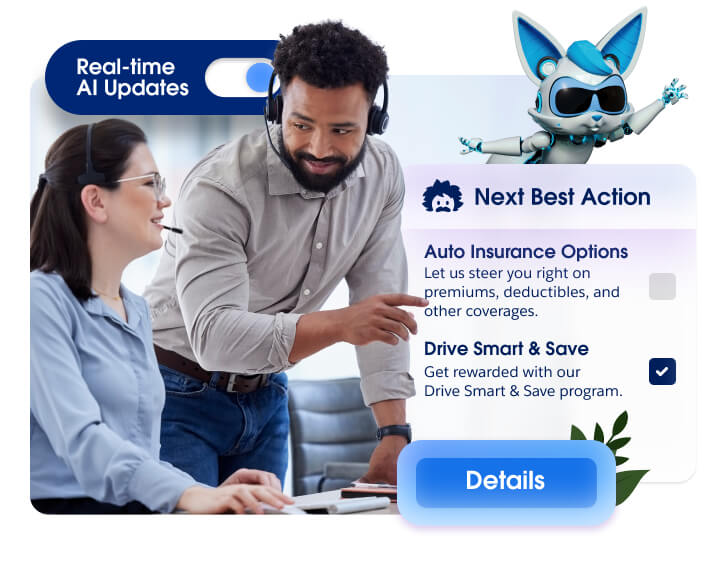4 Steps to Connected Marketing and Service Experiences
A unified marketing and service strategy can deliver more personalized customer journeys. Here's how to build yours.
Table of Contents
What do customers really want? This is a question that marketers and service teams have been grappling with for ages. With more ways to connect than ever before, the answer has become more complicated. On average, consumers engage with companies across eight channels, forcing companies to fine-tune their channel strategy. According to our “State of Service” report, 84% of company decision makers are reevaluating their channel resourcing to meet customers on the right platform at the right time. From promotional marketing to customer support, the multitude of touchpoints along a customer’s journey necessitates a more seamless, connected marketing and service approach.
Here’s a quick answer to the above question. Customers want a smooth experience, no matter how they choose to connect with a business — whether they visit your website, engage on social media, or contact customer service. In fact, customers’ number one frustration is a disconnected experience.
Agentforce — always-on digital labor — emerges as a powerful solution that makes customer experiences more unified and teams more efficient. By accessing connected data, agents allow teams to move beyond a top-of-funnel focus, personalizing the entire customer lifecycle with ease and accuracy. This approach not only delivers more relevant and consistent customer interactions but also improves the efficiency of marketing and service departments. By connecting experiences through data, agents can perform marketing efforts that proactively address potential service issues. This helps service representatives better scale their service delivery while ensuring a consistent and accurate customer experience.
In this article, we’ll break down four steps to building this connected marketing and service experience that benefits your customers and teams alike:

What is a connected marketing and service experience?
Connected marketing marries cross-departmental efforts to create seamless and personalized experiences across all customer touchpoints. It brings teams together to efficiently deliver exactly what the customer needs.
You might be surprised to know you already hold the key to a connected marketing and service experience — and it’s in your customer data. On average, marketers use nine different tactics to collect data across the entire customer journey, with customer service data as their most popular tactic. Similarly, 74% of service teams share their CRM and its data with sales and marketing. Why? A unified, connected marketing approach allows them to use each other’s data to personalize experiences at every stage of the customer journey — like targeted messages, personalized offers, and individualized support. A wide majority of service teams (80%) say even better access to other departments’ data would improve their work.
On average, marketers use 9 different tactics to collect data across the entire customer journey, with customer service data as their most popular tactic.
It’s one thing to collect and analyze the data. It’s another to turn the insights into action. Connected marketing depends on a centralized view of the customer. To access that, you must remove barriers between departments and manage data on a single platform. Agentforce is a new wave of artificial intelligence (AI) that offers the intelligent solution marketing and service teams need for a more flexible and personalized approach.
Agentforce is a complete AI system that integrates data, AI, automation, and humans to deploy trusted agents across any business function. It allows teams to create and customize agents, as well as use a library of ready-to-use skills for any use case across service, marketing, sales, and more. Marketers and service representatives define the overall strategy while agents handle the action, ensuring customer experiences are delivered effectively and efficiently.
Agents also help marketers and service representatives overcome the fragmentation that often exists between departments. Unlike previous AI tools, agents excel at integrating data from various sources, ensuring customers interact with the brand as a single entity, not a collection of disconnected departments. This seamless experience allows businesses to deliver personalized interactions, from answering questions and qualifying leads to resolving issues and recommending tailored products, content, or offers.
The agent performs the same tasks a marketer or service representative would, but with the advantage of real-time data that allows for faster execution. It provides up-to-date information, offers relevant suggestions, and assists in the decision-making processes. Imagine an agent autonomously identifying a customer service issue mentioned in a support ticket and proactively suggesting a targeted marketing campaign to address the underlying concern. Yet, this isn’t a linear process — the agent is intelligent, interpreting customer actions, processing data in the moment, and adjusting the journey on the fly. This seamless integration of marketing and service data allows teams to deliver truly personalized experiences while improving overall efficiency.
Connected marketing fosters trust, loyalty, and advocacy, ultimately unlocking new growth opportunities. Let's delve deeper into the four key steps that make this possible.

From marketing to support, Unified Conversations makes it easy to have two-way chats on WhatsApp with customers.
Keep: Acquire and retain customers for life.

Several factors hinder customer retention efforts. Disconnected customer experiences are a primary culprit, characterized by inconsistent messaging or service encounters across various channels. Slow resolution times for customer issues also erode loyalty, as do lapses in proactive engagement. In fact, 61% of service professionals say their organization addresses service issues proactively, but only 33% of customers agree that the typical company does this. When customers feel neglected or unsupported, they are more likely to seek alternatives.
Connected marketing offers a powerful solution to these challenges. By centralizing customer data and aligning marketing and service efforts, businesses can create seamless and personalized experiences. Let’s see what happens when marketing and service come together with Agentforce.
Connecting the dots with Agentforce.
To focus on customer retention, marketing and service must work in harmony. Marketing can use customer service insights to tailor campaigns and offers, while service teams can use marketing data to anticipate customer needs and provide more effective support. To build reliable customer retention, consider focusing on these key initiatives:
- Pausing marketing promotions: Prevent customers with open support cases from receiving promotional materials that could heighten their issues. An agent can identify customers with open support tickets related to a specific product and automatically suppress promotional offers for that product, demonstrating an understanding of the customer's needs and preventing potential frustration.
- Delivering cross-sell and upsell offers: Engage customers by providing personalized product and content recommendations based on what the customer has previously viewed. Agents can deliver tailored promotions and orchestrate next best actions across touchpoints and channels. Delivering cross-sell and upsell offers across channels ensures your messaging reaches customers wherever they are in their journey — whether through email campaigns, personalized WhatsApp messages, or targeted advertisements.
However, the approach doesn’t end with the initial offer. Agents can then deliver engagement indicators to service teams so they can recognize customers who may be receptive to additional offerings or upgrades. By using real-time insights and predictive analytics, service representatives can proactively address customer needs and facilitate valuable interactions.
- Running reengagement and win-back campaigns: Reconnect with dormant customers, revive their interest, and win them back. With access to customer behavior data, agents can identify these at-risk customers by analyzing specified churn indicators — such as low engagement or decreased purchase frequency — and autonomously send a tailored promotion based on their profile and guardrails set by the marketer.
Satisfy: Build customer happiness.

For one, inconsistent engagement across different channels confuses customers, creating a disjointed experience that diminishes satisfaction. The inability to use zero- and first-party data complicates personalization efforts, leading to irrelevant interactions that frustrate customers. And limited understanding of customer segments and the inability to create them make it difficult to deliver targeted messages. This results in impersonal experiences that fall short of customers’ expectations.
It’s hard to make everyone happy, but there are steps companies can take to emphasize customer satisfaction across marketing and service touchpoints.

Only 32% of marketers are completely satisfied with how they use customer data to create relevant experiences.
Connecting the dots with Agentforce.
When it comes to satisfaction, marketing and service teams should unite around the customer. In fact, 88% of service representatives say they share accountability for customer satisfaction KPIs with sales and marketing teams. When marketing teams understand the challenges service teams face, they can create campaigns that reduce support inquiries. When service representatives have insights into marketing goals, they can better anticipate customer needs and provide more enticing solutions. Together, they create a seamless customer experience that keeps customers happy and coming back for more — increasing efficiency and business growth all the while. Let’s look at a few ways you can do this with agents.
- Personalized, two-way conversations: Give customers a voice with two-way messaging prompts that create meaningful dialogue and gather real-time insights. Historically, chatbot capabilities have been limited, often relying solely on keywords or lacking WhatsApp integration. But with Agentforce, teams can use agents that act like personal concierges within WhatsApp. This provides seamless interactions, from personalized product recommendations to guided checkout and order updates. If needed, the agent can transfer conversations to human representatives, ensuring a consistent customer experience.
- Preference building: Use customer data to inform future personalization and proactive service outreach. Agents can autonomously analyze this data to identify patterns and trends, allowing teams to proactively address potential issues, anticipate customer needs, and deliver personalized experiences across all touchpoints.
- Proactive, not just personalized journeys: By anticipating needs and addressing potential pain points before they arise, you can demonstrate commitment to exceptional service and customer satisfaction. Using agents, marketing teams can create precise segments in minutes and define a target audience with ease. For example, you can use service data to better segment your customers by loyalty status or open customer service cases. By chatting with agents using natural language prompts, simply describe your ideal target audience. The agent will then ground that prompt in data from Data Cloud and translate these attributes into the appropriate segment attributes.
Accelerate: Speed up delivery of customer benefits.

For marketing, a shorter time to value means customers quickly realize the benefits of a product or service, leading to positive word of mouth and increased customer acquisition. For service teams, accelerating time to value ensures customers are satisfied with their purchase and reduces the likelihood of support issues or returns.
Without a connected marketing strategy, brands risk accelerating time to churn. Customers get frustrated when they can’t easily get what they need on their preferred channels. Additionally, if marketing and service teams lack a unified view of customer interactions, delivering timely messages becomes difficult and responsibility for their delivery isn’t clear. When customers are expected to coordinate with multiple representatives across different messaging channels, teams have to work harder to manage the complexity. Unfortunately, this leads to slow response times, low customer satisfaction, and negative brand perception.
AI tools, like Agentforce, can use predictive analytics to identify the most effective touchpoints for individual customers. It helps customers quickly grasp the product’s benefits with the right information on the right channel. In fact, 79% of service organizations are investing in AI. By automating routine tasks, such as lead qualification and customer onboarding, Agentforce frees up human resources to focus on higher-value activities. Agents can also provide instant self-service support and guidance, solving problems faster and preventing customer frustration.
Let’s break down more tangible ways Agentforce adds value to customer experiences.

79% of service organizations are investing in AI.
Connecting the dots with Agentforce.
Sometimes, all it takes is simple alignment to help marketing and service teams move toward the same goal. When marketing provides clear and accurate information about product benefits, customers will know how to use the product effectively. Service teams can provide valuable feedback to marketing on product features and usage challenges, helping to refine messaging and improve the overall customer experience. Agentforce helps deepen this internal alignment.
Agents can provide shared metrics, data-driven insights, and predictive analytics to foster collaboration between marketing and service teams. They can also automate transactional messages, such as order confirmations, shipping notifications, and password reset instructions. These AI initiatives help marketing and service teams manage all their efforts on one platform. This helps both teams work smarter, not harder, to deliver a superior customer experience.
- A warm welcome with personalized onboarding: Use agents to deliver hyperpersonalized welcome journeys that highlight product benefits from the start. AI-powered customer segmentation and predictive analytics help businesses create tailored onboarding experiences that reduce future service case volume and improve customer satisfaction.
AI can augment our Marketing Cloud journeys to dynamically adjust customer paths based on real-time behavior. Additionally, post-purchase surveys using AI can gather actionable feedback, informing future onboarding iterations and service improvements. - Automated renewal journeys: By using Agentforce to analyze customer data and identify engagement patterns, businesses can remind customers of upcoming renewals with personalized messages delivered through their preferred channels. This approach allows teams to craft tailored renewal messages that resonate with individual preferences. These timely reminders, whether for subscriptions, maintenance, or upgrades, keep brands in the forefront and facilitate seamless interactions.
- Personalized website experiences: Automatically add personalization to your website with tailored product recommendations, support resources, and next best actions based on customer behavior. Agentforce can help you greet visitors on your website, scaling the ability to provide personalized assistance to every visitor. Even anonymous visitors can benefit from AI-driven insights that guide them toward relevant information. This approach extends beyond the website, with AI-driven, open-time email personalization. This personalizes content at the moment an email is opened rather than when it’s sent.

The results are in. Learn what marketers and service professionals are saying about AI, data, and personalization.
Reduce: Decrease service center volume.

Understanding a customer's full story is tough when information is scattered across different teams. The majority of customers (79%) expect consistency across departments, but 56% often have to repeat information to different representatives. On the flip side, marketers often have limited insight into the root causes of customer issues, preventing them from addressing problems proactively. Disconnected data wastes everyone’s time, and service representatives have to pay for it.
Imagine a strategy that exceeds customer expectations and solves problems faster while reducing service center volume. That’s a connected marketing and service experience.
Connecting the dots with Agentforce.
Effective communication and a shared commitment to customer satisfaction are essential for driving down service volumes and contributing to the overall customer experience. Both teams need access to a shared view of the customer to pinpoint trends and issues. By collaborating to understand the root causes of customer inquiries with Agentforce, they can proactively address problems through the initiatives below.
- Self-service experiences: On average, self-service solves an estimated 54% of customer issues for organizations that use it. Apply agent workflows to facilitate simple self-service transactions, like appointment booking and promotional redemption. An agent can understand and respond to customer inquiries without human intervention — and it can do so in a way that considers the customer’s point of view. Over two-thirds of customers won’t use a company’s chatbot again after just one negative experience. If a customer’s question is beyond the agent’s capabilities, they can easily escalate the conversation to a human support representative, ensuring the customer’s needs are met. Companies that prioritize good customer service don’t just grow their reputation — they grow their business.
- Inbound inquiry deflection with personalized content: Use agents to anticipate your customers’ needs with proactive marketing and resources that leave them feeling valued. Automatically personalize touchpoints with support articles and educational content to deflect future problems.
- Real-time, personalized care: Agentforce can give service teams real-time access to online behavioral history for individual customers so they can preemptively offer assistance. The agent can even prompt representatives to share a “next best offer” or recommend products to complement customersʼ purchases.
Get started with connected marketing and service.
Effective connected marketing begins with a clear vision for improving the overall customer experience. Companies often fall into the trap of trying to implement every feature at once, leading to delays and budget overruns. Prioritizing customer needs and focusing on core functionalities are crucial. To succeed in connected marketing, marketing and service teams must align efforts around the customer.
Agentforce facilitates this collaboration by bringing the power of agents to the Salesforce Platform. Our Customer 360 delivers a single source of truth by uniting data across your business — including marketing and service — into one view of the customer across departments. Agents and employees can take action in any app, like Marketing Cloud and Service Cloud, around this shared customer view to improve experiences, increase productivity, and boost revenue.
Find your next steps.

7 Proactive Steps to Improve Customer Loyalty

How Personalized Marketing Keeps Customers Past the Honeymoon Stage

What Is Zero Copy? (and How It Works)
More resources

Unlock trapped data and deliver personalized experiences with AI.

Connect experiences across marketing and service.



